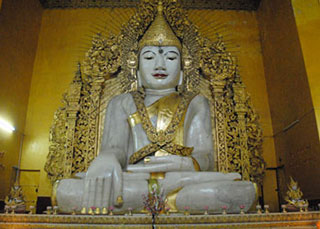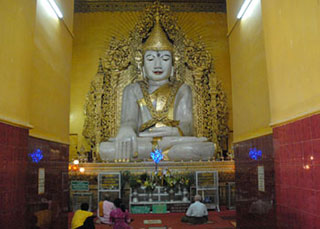You are welcome to Mandalay to enjoy many architectural marvels and artistic wonders of which the largest stone Buddha Image is the one that deserves special mention.
Officially named “Mahasakyamarajina” (The Great Conqueror of Mara and who was of Sakya race) but commonly called “Kyauk Taw Gyi” (The Great Stone Royal) the largest stone Buddha Image is housed in a big brick temple with an iron roof of a unique design. located just at the southern side of Mandalay Hill.


The colossal stone of which the Image was hewn is alabaster—an extra fine quality marble species which is easily mistaken for white jade when well polished. In Myanmar. alabaster is called “Sagyin Kyauk” because it is the stone quarried from the Sagyin hills lying twenty four miles north of Mandalay. The Sagyin hills. geologists say. are an off-shoot of the Mogok hill range. and so they produce rubies of some quality.
The story of the discovery of a large monolith was associated with the oral history of the second last Myanmar King Mindon. It was the time when the two Princes. Mindon and his younger brother Ka Naung who were halfbrothers of King Bagan (A.D. 1848-1853) raised a rebellion against the king. Fleeing from the royal troops who were in hot pursuit after him. Prince Mindon spent one night at Sagyin village. It was then and there that Prince Mindon heard about an enormous alabaster stone on the Sagyin hills. He made a vow that if he were to ascend the throne. he would make a Buddha Image of the stone. He became king in 1853. but his promise was fulfilled only twelve years after his ascendancy.
The quarry from which the big stone was extracted lay on the Kama hillock of the Sagyin hills. Most Sagyin stones used for sculpting sacred images are produced from the quarries on the southern side of the Sagyin hills. But the royal monolith was discovered on the northern end of the range. Besides its superlative size. the big stone has some unique qualities. It is almost flawless. because there are only two negligible blemishes— very unusual for an alabaster stone of super dimension. According to stone sculptors. it has five varieties of grain. three white grains and two black grains. which are easily visible on the Image.
How the enormous stone was brought down from the hillock and how the nearly finished Image was taken to Mandalay was graphically described by a noted woman writer of Mandalay named Ludu Daw Amar in her essay on the Image. The great stone was raised from the pit by means of levers. and sledges and runners carried it slowly to the foot of the hill range. Sculpting was carried out there for two to three years by two master sculptors U Toke Gyi and U Pike Htway. assisted by twenty to thirty apprentices.
Transportation of the stone Image to Mindon’s Capital is an interesting account of the Myanmar traditional engineering technique. The great load was floated down to the Ayeyarwaddy River by means of a twin barge. There are Sagyin Lake and Sagyin stream. which become connected with the River during the peak of the Monsoon. Two parallel canals were dug with a ridge between them. Before water was let into the canals. two strong flat bottom barges were constructed on either side of the ridge. Then strong thick planks were laid on the barges across the ridge so as to form a raft with two barges under it.
The stone Image was carefully trolleyed on to the raft. The canals were filled in with water and the loaded raft was gradually floated down to the Sayin Lake and then to the Sagyin stream which flows into the Ayeyarwaddy River. Men with bamboo poles steered the loaded raft along its water journey to the Mway village jetty on the river bank which was reached on 8 August 1864. From there one of the king’s steamers named Mya Nan Setkya hauled the loaded raft down to Mandalay. Four ministers. one junior minister. high-ranking civil and military officers were put in charge of the transportation of the stone Image. On 19. August 1964. Mya Nan Setkya arrived and anchored at the Ei Kin jetty on the Northwest of Mandalay. The arrival of the Image was announced by cannon salute and the king. his court and the public came out in boats to welcome the Image carrying party.
The loaded raft was hauled into Shwe Tachaung canal and at a point. the stone Image was transferred to a sledge with runners to take it to the site at the foot of Mandalay Hill. Under the supervision of Crown Prince Ka Naung Min. 12000 volunteers with great religious zeal. contributed their labour for 13 days in dragging the loaded sledge to the site—a distance of 4 to 5 miles. Such was the royal interest in the making of the Image that a progress report was daily telegraphed to King Mindon by a telegraphic line specially laid between Sagyin and Madaya.
On 16th May 1865. King Mindon made a Grand Progress from his palace to the Temple of the great alabaster Image. It was a state pageant composed of courtiers. and 15000 armed men who were archers. lancers. swordsmen. gunners. and artillerymen. and palanquins. sedan chairs. horses. elephants and chariots. True to the traditional composition of the Myanmar standing army. six battalions marched in the vanguard. and six battalions followed in the rearguard. with His Majesty (either on the Palanquin or on Royal Mount) and the ministers and courtiers in the middle. Between the battalions were parties of entertainers such as dancers. singers. musicians. acrobats. wrestlers etc.
The purpose of the grand pageant was to paint the face of the Image by the king himself and to consecrate the Image by the monks. When the pageant arrived at the Temple. King Mindon offered robes to the invited monks. Then he went up the platform to paint the eyebrows. eyes and lips of the Image. The two Ministers Lord Mya Daung and Lord Laung Shey who took the charge of bringing the big stone from the quarry to the Capital were honoured with the priviledge of painting the face after the king. Later professional artists carried out the finishing touches on the Image. Senior monks performed the rite of consecrating the Image by chanting the verse of Anekajatisamsaram. A concert of music and dances followed to mark the successful occasion of the opening ceremony. King Mindon awarded titles. promotions and cash to the ministers. officials. artists. craftsmen and sculptors and engineers who participated in the making and transporting of the colossal Image. The Sagyin villagers were exempted from 12 levies. and the whole Sagyin area was declared by royal order a Birds’ Sanctuary.
Artists who were present on the occasion. and who watched the progress of the king’s pageant painted the royal procession in colours on a folding white parchment. The parchment passed into the hands of one Mr. R.C.J. Swinhoe of Mandalay. after the British annexation of the Myanmar Kingdom in 1886. Mr. Charles Duroiselle. Superintendent of Archaeological Survey. Burma. printed in book form in 1925 the pictures on the parchment with his introduction and notes entitled Pageant of King Mindon leaving his Palace on a visit to the Kyauk Taw Gyi Buddha Image at Mandalay (1865). In 1987-88 the Pagoda Trustee and the Department of Archaeology in co-operation made enlarged reproductions of the pictures which are now exhibited in a zayat house by the side of the eastern causeway of the Temple.
The weight of the alabaster monolith (The Image and its pedestal) is 180 tons. The height of the Image alone is 27feet. The length of the face from the forehead band to the chin is 6.75 feet. Other parts of the Image body are in good proportion to the face. It is said that the Image was sculpted in correct ratio of Buddha Image as prescribed by Buddhist iconography. How large the Image is can be gauged from the fact that one can comfortably lie down in the palm of its folding left hand.
Regarding the temple which houses the Image. it was King Mindon’s intention to construct a Pagoda on the model of the Ananda Temple at old Bagan. But his intention was frustrated by the outbreak of the Myingun rebellion in 1866. The present roof of a peculiar design was dedicated by the Shan Chief of Yaunghwe. In the spacious precinct are the figures of the eighty disciples of the Buddha ranged around the central shrine. twenty on each side.
Counting the years from the date of its completion in 1865 the Kyauk Taw Gyi Image today (1997) is 132 years old. Luckily it has escaped natural calamities. human vandalism. and ravages of the Second World War. Mahasakyamarajina Image receives daily veneration of Buddhist pilgrims and the admiration of international tourists.
Dr. Khin Maung Nyunt
